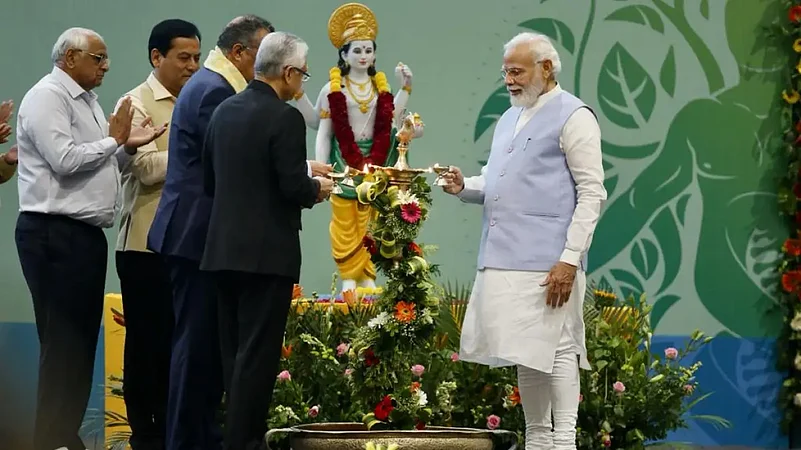In what is being hailed as a major push for traditional medicine across the world, Prime Minister Narendra Modi along with World Health Organization (WHO) Director-General, Dr Tedros Ghebreyesus, inaugurated the WHO Global Centre for Traditional Medicine in Jamnagar in Gujarat last month.
It was yet another attempt by the Modi government to promote traditional medicine in India.
In the last eight years, the government has created a separate AYUSH (Ayurveda, Yoga, Unani, Siddha and Homeopathy) Ministry to mainstream and streamline traditional medicine and founded the AIIMS-like All India Institute for Ayurveda (AIIA) to promote indigenous forms of healing and medicine, which, Modi rightly argues, had been systematically destroyed due to years of colonial rule and subsequent political neglect. The promotion of Ayurveda is part of the BJP’s larger agenda to revive Indian culture and heritage.
However, this project has also been intimately tied to the government’s Hindu nationalist politics. In traditional societies, health has always been deeply intertwined with people’s culture, environment, seasons, religion, rituals and social organisation – and not an autonomous sector divorced from other aspects of life. But now there have been concerted attempts to homogenise India’s myriad health practices – which differ from community to community, region to region and faith to faith – into a distinctly upper-caste system of medicine.
Animal products in indigenous healing systems
The popular image of the nationalised Ayurveda is largely plant and herb-based, a vegetarian system of healing. However, animal products are widely used in Ayurveda and other indigenous healing systems across different communities in India. In fact, the Charaka Samhita, the foundational Sanskrit text on Ayurveda is known to mention over 380 types of animal substances, including animal blood, bones, milk, skeleton or specific organs for treating a slew of diseases like asthma, tuberculosis, jaundice, paralysis, earache, etc. For example, owl meat is known to treat tuberculosis, while the blood of goats is considered good during blood loss. Far from frowning upon meat consumption, the Charaka Samhita further prescribes different types of meats that should be consumed according to different seasons of the year. For example, during spring, it states, “one should eat the meat of the sarabha (wapiti), sasa (hare), ena (antelope), lava (common quail) and kapinjala (grey partridge), and drink harmless vinegar and wines”. It even prescribes non-tobacco herbal smoking “as a daily routine for happiness”.
Yet, none of these eclectic and often very localised practices which survive largely among tribal and lower caste communities (for example, the Bawaria and Morgya tribes in Rajasthan) now find any mention in the nationalised and vegetarian version of Ayurveda. Most urbanised, upwardly mobile communities have already jettisoned these practices and taken to modern medicine.
Ayurveda and nationalism
Before the colonial rule, a large variety of traditional health practices existed across the country in caste and ethnicity-specific contexts. But since the British rulers copiously translated the dominant healthcare traditions recorded in the Samhita texts, a centralised version of Ayurveda emerged that pushed away from the other medicare practices. Significantly, the attempts to centralise Ayurveda emerged at the same time the idea of Hindu nationalism surfaced in the late 19thcentury as a response to colonial rule.
The trend continued after Independence as several leaders like former prime minister Morarji Desai or even leaders from the socialist left like former home minister Gulzarilal Nanda, in addition to the Jan Sangh, felt that modern medicine has been able to trample over indigenous health systems because of their decentralised, localised and ill-defined character. Therefore, attempts were made to organise these health practices that saw some select and well-documented practices of Brahminical elites receiving a greater space than others.
The Sanskrit-based Ayurveda thus received the maximum institutional and political patronage at the cost of other systems of indigenous medicines. For example, in 1962, a government committee, which advocated a “pure” Ayurveda, recommended a course of pure Ayurvedic training with fluency in Sanskrit as an admission prerequisite.
Significantly, there has been enough evidence of the co-existence of the Unani and Ayurveda systems of medicine well as exchanges between the two systems. But from the 19th century onwards a communal distinction had been drawn between Ayurveda as exclusively a Hindu system of medicine, and Unani as exclusively a Muslim system of medicine. It hurt the healthy development of the Indian system of native medicines, and eventually ensured the subordination of Unani to Ayurveda.
While consumer-friendly Ayurveda, being sold by big brands, had been most successful in cities, there also existed a segment in small towns and villages where mass-produced indigenous medicines were always a handy substitute. Ramdev’s multibillion-dollar Patanjali tapped into the sentiment of cultural loss and soon came to sell everything from infertility cures to jeans, neatly packaged for a global market with an ancient Hindu-sounding name.
Ramdev’s impact on indigenous healing practices and yoga in India can be compared to Ramanand Sagar’s Ramayana in the 1980s. While varying and decentralised renditions of the Ramayana had survived for millennia across the Indian landscape, it was his televised and mass-produced rendition of the Ramayana that came to create a collectivised and monolithic Ramayana that could be mobilised for political ends. Similarly, while indigenous health practices and traditions existed in deeply localised and decentralised settings across India, Ramdev’s version created a nationalistic consciousness about them.
In promoting a state-sponsored, Hinduised and consumerism-friendly Ayurveda, the government is trying to create nationalistic pride in “Indian” culture and catering to the global supermarket which is increasingly keen to go “back to nature”. However, this project threatens to delegitimize India’s already marginalised indigenous health traditions.
(Sanya Dhingra is a journalist and graduate student, South Asian Studies, Columbia University, New York.)
















